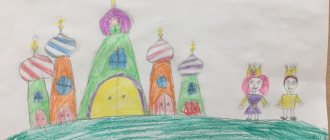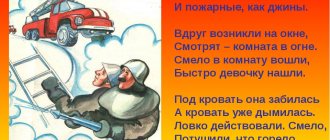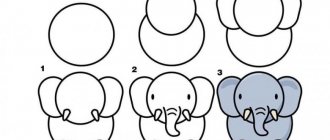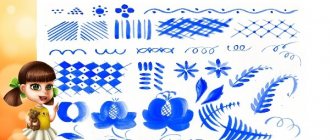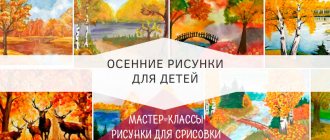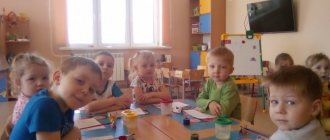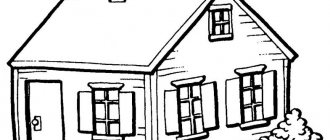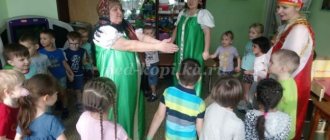Notes on drawing in the preparatory group “We are young designers”
Summary of the lesson on children's design " We are young designers " in the preparatory group
Goal: to develop in children an idea of design as a field of art in the objective world; about the value of design developments; about the structure of a specific labor process ( modeling , clothing production). Introduction to the new painting technique "frottage".
Tasks:
-Continue, generalize ideas about the connection between the labor of people employed in the same production.
— introduce children to the profession of fashion designer and its purpose.
— Introduce the work of great couturiers and designers (V. Yudashkin, V. Zaitsev).
-Introduce preschoolers to the non-traditional technique of texture drawing, frottage.
— To develop the ability to create design using the knowledge gained when performing practical tasks: decoration ( design ) of modern clothing.
-Improve shading skills, adjust pressure, select colors, strengthen the ability to create a composition.
— Develop the skills necessary for collective creativity, communication skills, observation, creativity, aesthetic taste.
-To develop the ability to bring the job started to completion, to work in a team. Arouse interest in non-traditional visual material and a desire to act with it. — Foster respect for the work of adults.
Material and equipment: pictures depicting great couturiers and designers -V . Zaitsev and his clothing collection, V. Yudashkin and his collection of designer clothing . A box with spools of thread, a tape measure, scissors, needles, chalk, a thimble, a small sewing machine, a piece of fabric, a pattern, a finished dress. Sketches of clothes on A 4 paper, wax crayons, soft colored pencils, various textures for placing under paper, samples of ready-made patterns.
Progress of the lesson
Organizing time
Educator: - Look guys, today I brought a beautiful box class Let's all see what's in it together?
The teacher takes one item out of the box and asks the children to name these items (thread, tape measure, scissors, needles, chalk, thimble, fabric, small sewing machine, pattern, dress style).
Educator: - Well done! Tell me, who works with these objects, and what can be done with the help of these objects? (Children’s answers).
Educator: - List the professions that relate to tailoring? (Cutter, seamstress, tailor, fashion designer) .
Educator: - You correctly named the professions of people who are engaged in tailoring.
- I invite you to play the Question and Answer game with me.
Questions: 1. All people are wearing something, where do they buy their clothes? 2. How did the clothes get into the store? Who sewed it? 3. What are the people who sew clothes called? 4. And if you can’t find what you need in the store, where can you sew clothes? 5. In the atelier, the person who cuts the clothes will take the order. What is the name of his profession? 6. They brought fabric to the seamstress and asked her to sew a dress. Where does she start her work? 7. What should you do before cutting a dress for sewing? 8. Where does a dressmaker get clothing designs ? 9. Who comes up with clothing models ?
— Not all people can sew and design beautiful clothes. You need to study a lot and love doing it, be a dreamer, and have aesthetic taste.
All professions: seamstress, cutter, fashion designer are closely related to each other and are employed in the same production.
Educator: - You are all great and answered all the questions correctly, correctly named the professions that are involved in tailoring and talked about the function of each.
Educator: - In today's lesson Fashion Designer better .
Main part: The teacher's story.
A fashion designer (in the Russian tradition) is a specialist in making clothing models , a clothing designer , a creator of experimental samples, developing decor, choosing colors and materials, thinking through accessories and additions.
— We will now get acquainted with two famous fashion designers who were the first to win recognition and fame in the fashion industry and glorified this creative profession not only in Russia, but also beyond the borders of our Motherland.
Vyacheslav Zaitsev is a couturier, artist, poet, president of the Moscow Fashion House, member of the Union of Artists of the Russian Federation, Honored Artist of the Russian Federation. Man of the Year in the Fashion World.
Born on March 2, 1938 in Ivanovo, in a working-class family. He graduated with honors from the Ivanovo Chemical-Technological College and received a qualification as an artist in textile painting. 1962 - graduated with honors from the Moscow Textile Institute. Worked at an experimental garment factory. Now he heads the Moscow Fashion House. V. Zaitsev conducts multifaceted creative work with young artists, fashion designers and designers . Largely thanks to his efforts, Russian fashion has reached the world level, taking its rightful place . (display of a clothing collection from V. Zaitsev)
Valentin Yudashkin was born on October 14, 1963 in the village of Bakovka, Odintsovo district, Moscow region.
passion for modeling manifested itself in school. Days and nights, the future couturier drew his first “ models ” and brought them to life himself. I made patterns, sewed from everything that came to hand - for myself and for friends. After passing the final exams, there was no question for Valentin where to go to study. The news of his decision upset his parents, who believed that the profession of a fashion designer was “not for men.” In 1981, Valentin entered the Moscow Industrial College at the Faculty of Modeling . Yudashkin was not stopped by the fact that there were only girls in his “ Fashion Design ” course. It turned out that from the very first steps in his profession, Yudashkin represented the Russian fashion industry abroad, collections of his works were demonstrated in all the world’s fashion capitals, some models of Yudashkin’s dresses are in the Museum Louvre costumes. Among celebrities, he is considered the king of wedding fashion. (collection show)
I bring to your attention a collection of other fashion designers who create beautiful dresses not only for adults, but also for children.)
(showing a collection of dresses for girls)
Educator: — Did you like the unusually beautiful, exclusive design works of fashion designers ? (answers)
I'm going to open a school for young ,
Would you, girls and boys, like to go to this school (yes) I’m very glad, but first, I say without further ado
Desire alone is not enough - everyone must be ready: DRAW - DRAW, CUT AND SEW Learn quickly, and for this we all
The School of “Young Fashion Designers ” will be very useful.
Educator: - I enroll everyone in the school of “ Fashion Designers ” and before going to work, I suggest they play the outdoor game “Figure with Scarves.”
(there is a dynamic pause accompanied by musical accompaniment)
Music sounds once, Music sounds two, Music sounds three, Beautiful figure with scarves, freeze. (play 2 times)
Educator: - What beautiful movements you performed to the music, and the figures were interesting, well done.
“And now I ask you to go to school and try yourself as a fashion designer and develop a collection of clothes, and since summer is coming soon, I propose to make a summer collection called “Bright Colors of Summer.” Guys, look at your tables there are clothing models. (Skirt, shorts, dress, T-shirt) - blanks cut out of paper. Choose any model for yourself. But your models are one-color and in order for them to become designer, you need to choose a fabric for them. Now we will paint your models using a technique called frottage. Stencils for our fabric can be any objects with a corrugated surface: a regular comb, napkins, lace, tree leaves, a vegetable grater, design parts, corrugated cardboard, a mosquito net, wallpaper with a convex pattern. You need to take a stencil and place it under your sketch, select wax crayon that you like and shade the model. Using textured surfaces and colored pencils or wax crayons, you can create not only beautiful fabrics, but also original designs.
Educator: Guys, I suggest you choose stencil templates and get to work.
You need to draw carefully, do not go beyond the outline of the figure, paint each detail in one direction, hold the base, select the appropriate colors.
Independent work of children using the Frottage technique. Individual assistance for everyone.
Educator: Today you are all great! You tried very hard, you got good and interesting outfits. Let's arrange an exhibition of works. (works are hung on the board, children comment on their works, each work is discussed).
Educator: - When you become adults, maybe one of you will become a famous fashion designer , cutter or tailor.
Lesson notes for children in the preparatory speech therapy group. Cloth
Class in a preparatory speech therapy group at a preschool educational institution.
Topic “Clothing” Author: Matveeva Alla Valerievna, teacher of the Municipal Children's Educational Institution No. 18 “Korablik”, Razvilka village, Leninsky district, Moscow region. Description: Dear colleagues. I bring to your attention a summary of a lesson on cognitive development for children of the preparatory speech therapy group “Clothing”. This material will be of interest to teachers when working with children of senior preschool age. The summary is aimed at deepening children's knowledge about clothing. Integration of educational areas: speech development, cognitive development, artistic and aesthetic development. Goal: Consolidating children’s knowledge on the topic “Clothing” Objectives: Educational:
Teach children to write descriptive stories.
Continue to teach how to think about the content of your work, implement your plan, and complete what you have started. Developmental:
Clarify the names of clothes and their details.
Reinforce the concepts of types of clothing. Practice using possessive pronouns. Develop fine motor skills of the fingers, speech, memory, logical thinking, imagination. Improve compositional skills. Form aesthetic taste. Enrich your vocabulary, expand your horizons. Educational:
To foster independence, activity, perseverance.
Vocabulary: cuff, frill, hem. Material: plasticine, silhouettes of clothes cut out of cardboard of different colors, pictures of clothes. Equipment : modeling boards, typesetting cloth. Media objects: poems, stories, pictures. Preliminary work with the integration of educational areas: talking with children about clothes, looking at illustrations, pictures, making attributes for the S/R game “Atelier”.
Progress of the lesson:
Ich.
Organizing time. - The one who can name what is shown in the picture will sit down.
(Pictures depicting clothes are placed on the typesetting canvas.) - Today we continue to talk about clothes. IIch. Main. 1. Reading the poem “Dress”
- Guys, listen to the poem: A dress without a frill looks simple, I ask the dressmaker: “Make some magic on it.”
A silk dress, a skirt with flowers, I can imagine myself in it, it’s so beautiful - ah! “It would be nice to sew a frill to the dress. I’ll have fun walking around in this dress.” Sleeves - lanterns, white cuffs, thin belt, there is no better dress! The round buttons sparkle merrily, I’ll wear a new outfit on my birthday! IN AND. Miryasova, S.A. Vasilyeva. - Guys, what is this poem about? (children's answers) - Listen to it again and name the details of clothing that are listed in the text. (Reading a poem based on a visual aid) 2. The teacher’s story about clothes.
Clothes were invented by people in ancient times.
It was made from the skins of animals killed during hunting. Clothes helped people keep warm. Gradually they learned how to make fabrics, and the clothes began to change. Women especially paid great attention to clothing and wanted it to decorate them. They sewed clothes for the street, for the home, for holidays, for girls and boys. 3. Conversation about types of clothing.
— Guys, name what types of clothes do you know?
The children list:
- We wear outerwear when going outside.
— Clothing that is put on the body is called underwear. — We wear festive clothes for the holiday. — The clothes we wear every day are called casual. — The clothes we wear in winter are called winter. — The clothes we wear in summer are called summer. — The clothes we wear in autumn and spring are called demi-season. We wear it between seasons, between summer and winter. 4. Game "Fourth wheel". The teacher pronounces a chain of words. Children name which item is extra and explain why. Dress - sneakers - raincoat - trousers (Extra sneakers, because they are shoes, and everything else is clothes). Skirt - sweater - pajamas - hat. Boots - blouse - raincoat - overalls. Jacket - jacket - scarf - gloves. Shorts - dress - trousers - felt boots. 5. Game “Shop”
Compiling a descriptive story according to a plan based on a diagram.
(What is it? What parts does it consist of? What material is it made of? What time of year is it worn? Who wears it?). 6. Physical exercise.
Speech with the movement “Shirt” The shirt has two cuffs,
Children show the cuffs on both hands
Collar
Show the collar
and sleeves,
Run their palms along the sleeves.
There are buttons to make it easier
Show the buttons from top to bottom
The head goes through.
Let's fasten the buttons . Imitate the movements
. And then we'll go for a walk
. March in place. 7. Practical part.
Decoration of clothes. The teacher invites the children to choose the silhouette of clothing that they would like to decorate.
Notes that the collar, pockets, buttons, cuffs, belt, hem, etc. can be marked on clothing. The work is done using plasticine. - Guys, today I suggest you decorate clothes using plasticine. Choose your clothes and think about how you would like to decorate them. During the work, the teacher provides individual assistance to children as they encounter difficulties. III part.
Summary of the lesson. Assessment of children's activities. Examination of works by children.
- What did you and I do today? - What did you do? - What did they talk about? - Look at the beautiful work you have done. —Who liked what work the most and why? (children's answers explaining their choice) - You all did well today. We did well. Everyone did their best. I really liked your work. We will take them to the exhibition in our dressing room so that your parents can admire our works. The lesson is over. Get your workspaces in order and relax. Literature: 1. “From birth to school. Sample preschool education program." Edited by N.E. Veraksy, T.S. Komarova, M.A. Vasilyeva, “MOSAIC-SYNTHESIS”, 2014. 2. “Development and correction of speech in 6-year-old children” Kuznetsova E.V., Tikhonova I.A. 3. “Integrated lesson: familiarization with the outside world and speech development” Selikhova L.G. 4. “Speech therapy in kindergarten” Smirnova L.N.
We recommend watching:
Abstract of the GCD on the topic: Winter for children of the preparatory group. Summary of a lesson on speech development for children of the preparatory group. Early spring Summary of GCD in the preparatory group on the topic: Circus. Speech development Joint activity for children of the preparatory group. Travel through fairy tales
Similar articles:
Summary of the lesson “Take care of nature” in the preparatory group
Summary of educational activities for children aged 6 - 7 years on the topic: “Introduction to Russian folk costume”
Children's answers. The teacher leads the children to the conclusion: there are different costumes, there are men’s and women’s, there are festive and casual (less elegant).
Teacher:
— Our country, Russia, is very large, so in different parts of our country, people’s costumes differed from each other. In the south, a woman's costume consisted of a shirt and a blanket. Ponevy is a woolen skirt worn over a shirt. The hem of the shirt was decorated with embroidery. An apron was a mandatory element.
-What do you think an apron is?
Children's answers and assumptions.
Teacher:
- Each of us is familiar with the apron. This is the apron that our mothers often use when preparing dinner. The apron protected clothes from contamination and hid the undecorated parts of the costume. Now our mothers wear an apron so as not to get their clothes dirty.
— Girls usually wore a bandage or ribbon on their heads. The festive costume was necessarily complemented with jewelry.
The teacher brings in a women's northern costume. Shows it to children.
- This is the costume that women wore in the North. The basis of the costume was a sundress. Sundresses were made from a variety of fabrics. An important part of the costume was a warm jacket - a warm jacket, usually sleeveless. Tell me, what piece of clothing does the shower jacket look like?
Children's answers: vest, bolero.
Teacher:
— In the North, women wore headdresses called kokoshniks. Kokoshniks were decorated with beads, pearls, and foil. Women wore their festive costumes to the fair, to festivities, where there were always games. I suggest you play the Russian folk game “Sugar”.
Round dance game "Sugar".
Teacher:
— Let's continue our tour of the costume exhibition. Men's costumes were less varied. The shirt was called a kosovorotka, trousers were called flogs, in summer they wore bast shoes on their feet, in winter they wore felt boots. The shirt was decorated with embroidery and belted with a belt. Men wore a cap on their heads.
And now I invite you to play the game. The game is called “And here we are.”
Teacher:
— I will name the element of the Russian costume, and you call it what we call this element of the costume:
- in the Russian folk costume, bast shoes, and in ours - ........ (shoes, boots, sandals)
- in Russian folk costume there is an apron, and in ours - ……… (apron)
- in Russian folk costume there is a cap, and in ours - ………… …(cap, cap)
- in the Russian folk costume of a dushureka, and in ours - ……….. (vest, bolero)
- in the Russian folk costume of Poneva, and us - ………. ………..(skirt)
- in a Russian folk costume - a sundress, and in ours - ……………. (sundress)
Teacher:
- Well done, they called everything correctly. And now I invite you to the workshop.
Children sit at tables and choose their own braid. The girl weaves a belt from braid, and the boys make a forehead amulet.
